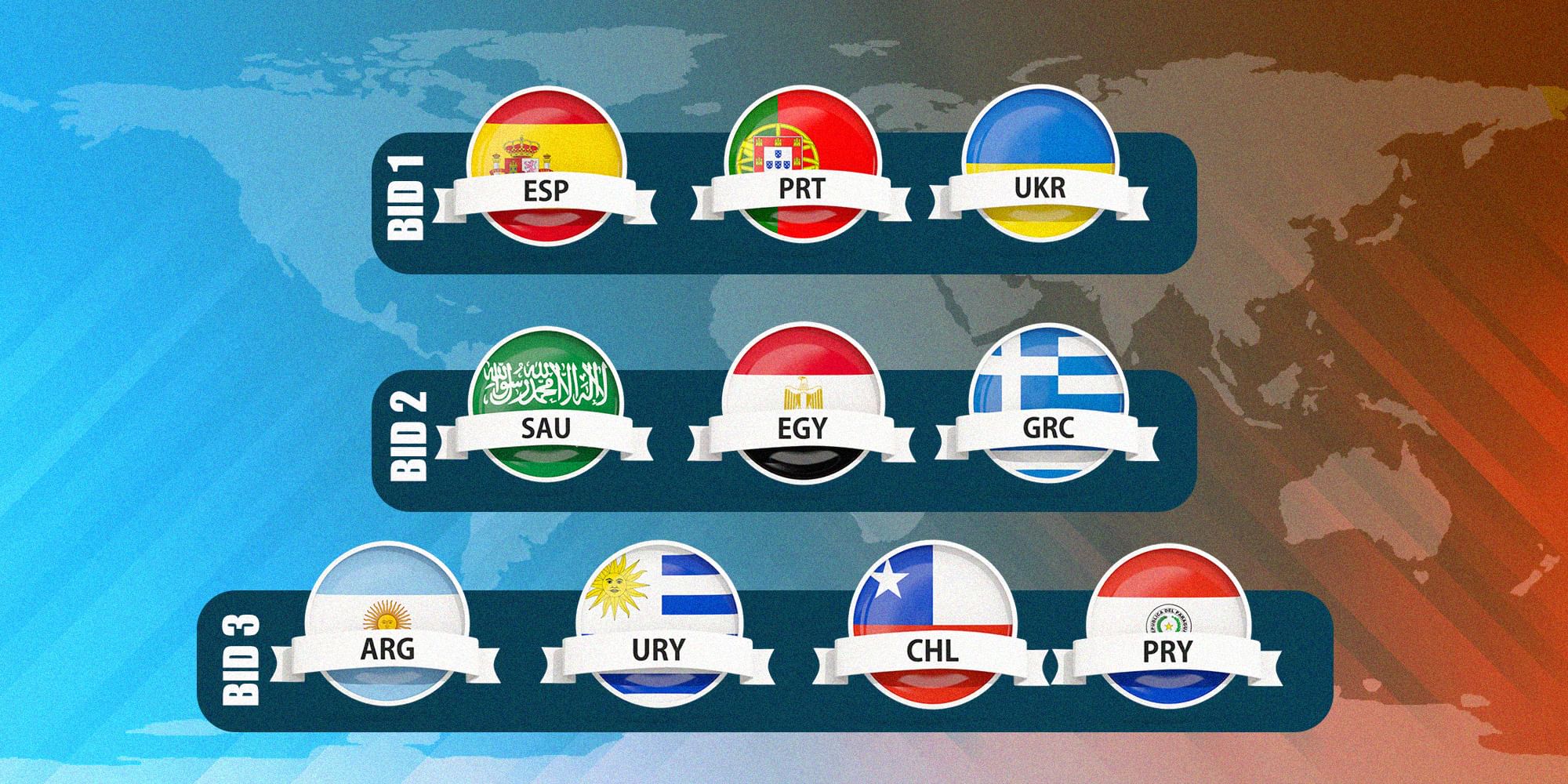The Rise of Joint Bids in Major Soccer Tournaments

The landscape of major soccer tournaments, such as the FIFA World Cup and UEFA European Championship, has witnessed a notable trend in recent years: the emergence of joint bids. This shift from individual nations vying for hosting rights to collaborative efforts between multiple countries has reshaped the bidding process and sparked debate within the sporting world.
Factors Driving the Trend
The surge in joint bids for major soccer tournaments can be attributed to a confluence of political, economic, and sporting considerations.
- Political Considerations: Joint bids often reflect a desire for regional cooperation and unity, fostering diplomatic relations and showcasing shared values. For example, the successful joint bid by Spain and Portugal for the 2018 FIFA World Cup highlighted their commitment to trans-border collaboration and a shared passion for the sport.
- Economic Considerations: Joint bids can significantly reduce the financial burden associated with hosting a major tournament, spreading the costs across multiple countries. This can be particularly attractive to nations with limited infrastructure or financial resources. For instance, the 2026 FIFA World Cup, which will be hosted by the United States, Mexico, and Canada, demonstrates the economic viability of joint bids, leveraging the combined resources of three North American nations.
- Sporting Considerations: Joint bids often aim to enhance the overall experience for fans and athletes, providing access to a wider range of stadiums and facilities. This can create a more diverse and engaging tournament, offering a broader range of cultural experiences for participants and spectators. The 2020 UEFA European Championship, hosted by 12 countries across Europe, exemplifies this approach, creating a truly continental celebration of the sport.
Examples of Successful Joint Bids, Joint bid trend dominating major soccer tournaments
The recent history of major soccer tournaments provides several examples of successful joint bids, demonstrating their impact on the participating countries.
- 2002 FIFA World Cup (South Korea and Japan): This joint bid marked a historic moment, showcasing the growing global reach of the sport and highlighting the potential for collaborative hosting. The tournament was a resounding success, with record attendance and significant economic benefits for both nations.
- 2018 FIFA World Cup (Russia): Although Russia’s bid was initially met with skepticism due to its political climate, the successful hosting of the tournament showcased its ability to stage a major international event. The tournament fostered a sense of national pride and boosted Russia’s global image.
- 2020 UEFA European Championship (12 countries): This unprecedented joint bid, spanning 12 countries across Europe, aimed to create a truly continental celebration of the sport. The tournament was a testament to the collaborative spirit of European nations and their shared passion for football.
Benefits and Challenges of Joint Bids

Joint bids for major soccer tournaments have become increasingly popular in recent years, offering a unique approach to hosting these global events. This strategy presents both advantages and disadvantages that need careful consideration.
Advantages of Joint Bids
The potential benefits of joint bids are significant, offering a compelling argument for their adoption. Joint bids allow nations to pool resources, share infrastructure, and expand their fan base, contributing to a more successful tournament.
- Increased Resources: Joint bids allow countries to combine their financial resources, making it easier to meet the substantial costs associated with hosting a major tournament. This shared financial burden can enable the creation of world-class facilities and infrastructure, enhancing the overall tournament experience. For example, the 2026 FIFA World Cup, hosted by the United States, Canada, and Mexico, leveraged the combined financial strength of these nations to build and upgrade stadiums, transportation networks, and other essential infrastructure.
- Shared Infrastructure: Joint bids allow countries to share existing infrastructure, reducing the need for significant new investments. This shared approach is particularly beneficial when countries already possess suitable stadiums, training facilities, and transportation networks. The 2012 UEFA European Championship, co-hosted by Poland and Ukraine, successfully utilized existing infrastructure in both countries, showcasing the benefits of shared resources.
- Expanded Fan Base: Joint bids offer the potential to attract a larger audience, as multiple countries contribute to the overall experience. This expansion of the fan base can boost tourism, generate economic activity, and create a more vibrant atmosphere around the tournament. The 2019 Rugby World Cup, held in Japan, demonstrated the power of a joint bid, drawing fans from across the globe and showcasing the unique cultural experiences of the host nation.
Challenges of Joint Bids
While joint bids offer numerous advantages, they also present a set of challenges that need to be addressed effectively. These challenges include logistical complexities, competition for resources, and potential conflicts between host nations.
- Logistical Complexities: Coordinating multiple countries in a joint bid can be logistically challenging. This requires effective communication, coordination, and collaboration between different governments, organizations, and stakeholders. Ensuring smooth operations, efficient transportation, and seamless fan experiences across multiple countries demands meticulous planning and execution. The 2006 FIFA World Cup, hosted by Germany, successfully navigated these complexities, showcasing the potential for a well-organized and coordinated joint bid.
- Competition for Resources: Joint bids can lead to competition for resources, as each country seeks to maximize its benefits. This competition can manifest in areas such as stadium allocation, match scheduling, and marketing opportunities. Careful negotiation and a collaborative approach are essential to ensure fair distribution and minimize potential conflicts. The 2014 FIFA World Cup, hosted by Brazil, faced challenges in managing resource allocation and ensuring equitable benefits for different regions within the country.
- Potential Conflicts: Joint bids can sometimes lead to conflicts between host nations, particularly regarding the distribution of benefits, allocation of responsibilities, and decision-making processes. These conflicts can arise from differing priorities, cultural perspectives, or political agendas. Effective communication, transparency, and a shared commitment to the tournament’s success are crucial for mitigating potential conflicts.
The Future of Joint Bids in Soccer: Joint Bid Trend Dominating Major Soccer Tournaments

The increasing popularity of joint bids for major soccer tournaments signals a shift in the landscape of international football. This trend, fueled by various factors, is poised to have a profound impact on the future of the sport, shaping how tournaments are organized, hosted, and experienced.
Factors Shaping the Future of Joint Bids
The future of joint bids will be shaped by a confluence of factors, including FIFA regulations, technological advancements, and evolving fan preferences.
- FIFA Regulations: FIFA’s stance on joint bids plays a crucial role. The governing body has been receptive to joint bids, recognizing their potential benefits. However, FIFA may introduce specific regulations to ensure fairness and prevent potential conflicts. For instance, FIFA might establish guidelines on the distribution of matches across host nations, the number of stadiums required, and the minimum infrastructure standards.
- Technological Advancements: Advancements in technology, particularly in transportation and communication, will likely facilitate joint bids. High-speed rail networks, improved air travel connectivity, and robust communication infrastructure will enable seamless movement of fans, teams, and officials across host nations. This will minimize logistical challenges and enhance the overall experience.
- Evolving Fan Preferences: Fan preferences are constantly evolving, and joint bids offer opportunities to cater to diverse demands. Fans may be drawn to the prospect of experiencing multiple cultures and destinations within a single tournament. Joint bids can also offer more affordable travel options, as fans can explore different cities without the need for expensive intercontinental flights.
Potential Long-Term Consequences of Joint Bids
The increasing popularity of joint bids could lead to significant long-term consequences, potentially reshaping the dynamics of international soccer tournaments.
- Increased Competition: Joint bids could lead to increased competition for hosting major tournaments. This competition could drive nations to invest heavily in infrastructure and create world-class facilities, ultimately benefiting the sport. The 2026 FIFA World Cup, which will be jointly hosted by the United States, Canada, and Mexico, exemplifies this trend, with each nation investing in state-of-the-art stadiums and transportation networks.
- Greater Global Reach: Joint bids can expand the global reach of tournaments by attracting fans from multiple regions. This could lead to increased viewership and revenue, fostering further growth of the sport. The 2019 FIFA Women’s World Cup, hosted by France, witnessed a surge in global viewership, demonstrating the potential of joint bids to reach a wider audience.
- Enhanced Sustainability: Joint bids can promote sustainability by spreading the environmental impact of hosting a major tournament across multiple locations. This can help reduce the carbon footprint associated with hosting events and promote responsible tourism practices. The 2020 UEFA European Championship, hosted across 11 European nations, showcased the potential for joint bids to contribute to sustainable tourism.
Joint bid trend dominating major soccer tournaments – The trend of joint bids dominating major soccer tournaments, like the recent World Cup, has been a hot topic. This kind of collaboration is certainly shaking up the world of sports, and it’s interesting to see how this compares to the recent news that the architect of the LIV Golf deal has left the PGA Tour.
It’s fascinating to see how these different sports are dealing with the changing landscape of competition and the rise of joint ventures.
The joint bid trend dominating major soccer tournaments is a testament to the power of collaboration. It’s a trend that’s bringing together nations and continents, much like the iconic vitra eames plastic side chair dss brings together form and function.
This collaborative spirit is essential for the success of these events, ensuring a wider reach and deeper impact on the global stage.
